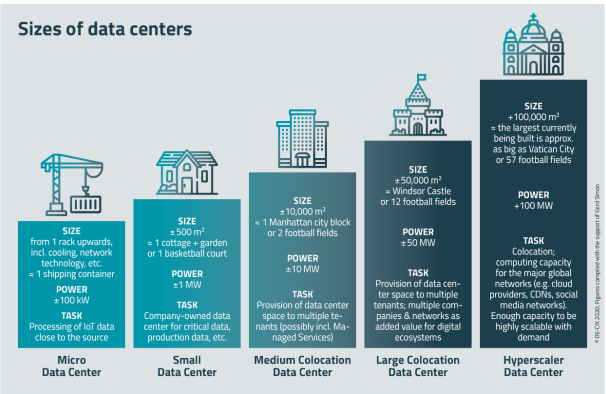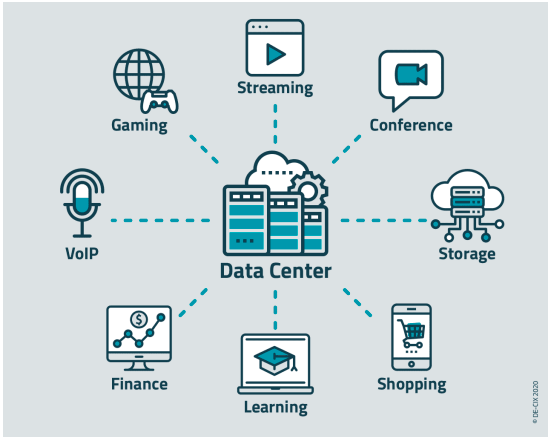From storage evolution to digital revolution
“Internet Exchange Points,” comments Gabriel Willigens, Head of the Business Unit DataLogistIX at Itenos, “live in data centers.” There’s a good reason for this: that’s where data lives. Today, data centers are the warehouses of the digital economy, providing a home not only for the data itself, but also for the platforms and applications that have become so ubiquitous in the modern world. And central to the seamless functioning of these applications and delivery of content is interconnection – which is why IXs like DE-CIX also make themselves at home in highly interconnected data centers in order to nurture digital ecosystems there.
But clearly, it hasn’t always been like that. Prehistoric data centers (those that existed long before anyone even thought of coining terms like “digital native”) were computer rooms located in company office space, housing – seen in retrospect – massively oversized and underpowered computers, and connected to nobody and nothing outside of the premises. It was a combination of the evolution of computing technology (not only miniaturization and transistor density, but also the capacity for computer resources to be shared amongst multiple users) and the increasing desire to connect networks with each other which together spawned the commercial Internet. With this, a new type of dedicated data center facility developed, along with new business cases for their operators. And so began the business of colocation – without which the Internet as it is could never have developed.
The co-dependent development of the Internet and data centers
To gain access to the Internet – today, as it was back then – connectivity is an essential precondition. In the mid-90s, with the advent of the World Wide Web, networks outside of the USA still needed to connect directly with the American backbone in order to access the new-fangled Internet. “An e-mail from one ISP to the other went to Washington and came back on the same line to be delivered to the provider next door. This was of course very expensive – a 2-Mbit direct route to US was a big thing. It was a privilege to have such a line, but costs were too high,” Harald A. Summa reminisces about the early days.
When DE-CIX first connected networks in Germany back in 1995, the first data center where the networks housed their networking equipment was a computer room in a disused post office in Frankfurt. But while connecting the first three German networks could be handled in such a space, it became necessary for the fledgling Internet Exchange to move to a dedicated colocation facility, as more and more networks wanted to connect their servers locally as well – so in 1999, DE-CIX moved to Interxion’s first Frankfurt data center, FRA 1. This was the beginning of a strong and mutually beneficial friendship, without which the Internet would not be what it is today.
The pioneering spirit of interconnection – no limits
Coming up to the turn of the millennium was a time of enormous growth in the market of data center services – companies that wanted to connect to the Internet but did not want to invest in their own in-house infrastructure began placing their servers in already functioning data centers, where the facilities could be shared between all tenants. The more companies and networks that accumulated within these data centers, the more attractive they became for other companies and networks to interconnect with. Digital ecosystems began to evolve, and the colocation market boomed. As Gerd Simon, at the time the Managing Director of Interxion in Germany, explains, “The mood was very energetic back then, there was a pioneering spirit – everything was possible. There were no limits. Everyone was looking for possibilities to develop their business, and looking for conversation and business partners in order to do that.”
Using DE-CIX as a way of then interconnecting networks not only within a building, but also between data centers, became a success story for the digital hub of Frankfurt – which has developed into one of the areas with the largest data center density anywhere in Europe.
Getting closer to the edge and increasingly interconnected
Certainly, the development of the colocation business model was not without its hiccups. With the bursting of the dotcom bubble in the early 2000s, these once flourishing colocation facilities emptied – the yawning white space in limbo as it waited for the hoped-for recovery. And bounce back it did; slowly at first, but with the emergence of the iPhone in 2007, a new form of Internet access demanded increasing infrastructure to feed a new generation of services to a willing world. Offering services for an increasingly mobile end user meant that networks needed to get closer to the user. This meant that networks needed to be connected with more data centers, and data centers needed to be connected with each other – and this needed to be done on both a global and a local scale.
The Internet was, after all, a global phenomenon. Local connectivity became the enabler for access to the world. Connecting to an Internet Exchange like DE-CIX functioned as a portal to the entire globe – it brought businesses to users, but it also brought users to these businesses.
From a refurbished office space to virtual infrastructure
From a couple of servers in a stand-alone rack, to containers for building modular data centers, through to purpose-built data centers offering managed IT services to SMEs, on to large colocation facilities with around 10,000 square meters of white space (equivalent of nearly 2 football fields filled with racks of servers); and onwards and upwards to major data center campuses and hyperscaler data centers offering upwards of a million square meters of computing space (in which, for example, the major platform providers and cloud service providers run their services). The variety of sizes, designs, and purposes that all fall under the term “data center” almost belies definition.

And going beyond these, data centers are taking on new conceptual forms. On the one hand, there are several initiatives seeking to federate a wide variety of data centers and services to create a virtual, open, neutral, and distributed cross-border infrastructure. In so doing, quality assurance and compliance requirements are being addressed, to enable customers simplified and secure control over their processes and their own data in the cloud, as well as data governance and interoperability, to gain the necessary flexibility for emerging digital services like AI. One example of such an initiative is the European project GAIA-X.
On the other hand, we see the emergence of edge data centers – highly localized, miniaturized processing capabilities to provide almost real-time responses and so enabling scenarios like autonomous transportation. Thus, the concept of the data center has always evolved alongside its potential to be used for the coming generations of digital services and digital business.
In the evolution of the data center as a building – from an office space in the early days, to refurbished commercial space, to purpose-built buildings, to modular containers on the one hand and hyperscalers on the other, and through to the minimalistic concepts now evolving in the edge data center space – land has also played a key role. Property owners and developers even in the late 1990s began to realize that a building with connectivity was more valuable for companies wanting to get online. Connectivity started to become a defining element of commercial property, and with this, digital had begun to have a real and lasting impact on the analog world.
The data center as mission-critical for companies, the cloud, and the Internet
By the second decade of the digital millennium, demand for data center space had developed radically, and data center operators realized that refurbished standard buildings no longer offered them what they needed to provide a modern service. Concepts like security, accessibility, and reliability were becoming business critical for their customers – from startups to global enterprises – and therefore also for the data centers themselves. So a new industry developed in the design and construction of new, purpose-built data centers.
In the early 2010s, the data center industry began a process of professionalization. Designs began to offer fail-safes against potential down-time and single points of failure, and classification systems began to offer potential customers a rating system on which to base their IT outsourcing decisions. Designs ensured redundancy in terms of connectivity and power. Sites were chosen for their proximity to other networks, to fiber, to power stations, and for their distance from geographical, environmental, and structural dangers.
This last point hinges on the fact that the analog world can also have a significant impact on the digital world. Jens Prautzsch, Managing Director of Interxion in Germany, describes it thus: “If you enter a data center, go past the security, into the data rooms, you feel the heat, you feel the noise, and you think, wow, what is in there? And then if you have in mind all the services, the customers that are in there, the systems and platforms that are running there, you feel the responsibility. You understand how important it is that we do a great job.”

Exploring the edges
The more interconnected data centers operating within close proximity to one another, the greater the interconnectivity gravity becomes, attracting more and more data center operators to build nearby, bringing more and more networks that want to access and participate in the increasingly dense ecosystems of digital hubs. The mushrooming interconnectivity in Frankfurt, for example, nicely illustrates the profound effect that digitalization has been having on our world for the last two decades. Without these ecosystems of data centers, the networks connected to them, and Internet Exchanges like those from DE-CIX interconnecting them, the Internet would not, and could not, have developed as it has.
The data center landscape of the future
So, where is the data center heading now? Well, probably in as many different directions as there are data center concepts today. The edge is a whole new territory to be explored, to be populated with sensors and processors and connected to fog and cloud computing solutions for further processing and storage. Looking in another direction, data center designers and hardware manufacturers have been engaged in an ongoing process of increasing energy efficiency – a trend which is set to continue well into the new decade. Here, not only is the infrastructure being designed to consume less power, and the heat generated in the data centers is being redirected into local heating networks, but data centers are being designed to operate in climatically opportune, but thoroughly unexpected places. Take, for example, mines, churches, or even underwater locations.
Whatever the future of data centers and the Internet as a whole may bring, DE-CIX will be there, together with our many data center and connectivity partners all over the world, providing the portal to the next generations of interconnection. Without these valued data center and connectivity partners – providing access to DE-CIX in more than 500 data centers, in over 80 countries, across four continents – without you, DE-CIX would not have a story to tell.




